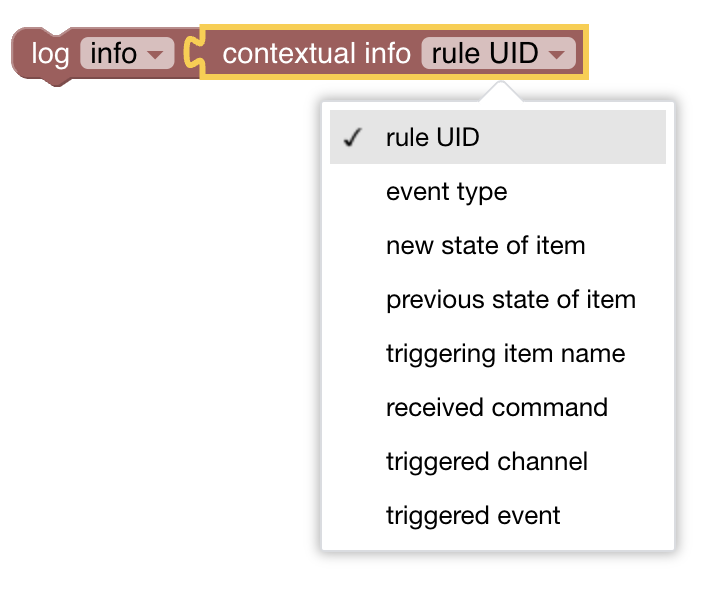This page is part of archived documentation for openHAB 4.1. Go to the current stable version
# Run & Process (Rules and Scripts)
# Introduction
This section contains several possibilities
- Calling Rules or other scripts either located as files on the server or provided via the UI
- Retrieving attributes provided by the rule context or from the own caller rule.
- Transforming values via different conversion methods (map, regex, jsonpath)
A note about Rules and Scripts
A Script is a Rule too. It’s just a special type of rule that only has a single script action and a “Script” tag.
# Overview of the Run & Process blocks

# Run & Process Blocks
See also the short video part about Run & Process blocks, transform (opens new window)
# Call Script File
Function: Calls a script file with the given name which must be located in the $OPENHAB_CONF/scripts/ folder.
- No parameters can be provided
See openHAB Call-Script (opens new window) for background information
# Run Rule or Script created in UI
Function: calls another rule or script that was created via the openHAB UI.
The ruleUID can be found in the list of rules or scripts in the second line of the list (like here helloBlockly or helloWorld)
Parameters are optional:
- If not providing parameters leave the with context section as is.
- If providing parameters you must replace the create empty dictionary block with the dictionary block from the Lists section (opens new window), modifying the number of key/value pairs to suit.
Notes:
- parameters can be retrieved in the called script via the "get context attribute"-block (see below)
- the called rule / script cannot return any value
- it is not possible to access a particular function in another script or rule as scripts / rules have to be perceived as completely autonomous
- the called rule / script is run synchronously
# Retrieve context attribute from rule
Function: Retrieve context attributes passed by a calling rule/script (see above)
This retrieves the value for the key "myKey1" that was passed by the calling rule.
Example

# Retrieve rule context information

Function: Retrieve event context related information of the rule
A rule carries contextual information when triggered - this block can retrieve that information.
- The rule trigger type defines which of the attributes are available to the rule - the types available depend on the trigger type of the rule.
- For more detailed information see UI Event Object (opens new window) or openHAB Events (opens new window).
Here is a list of possible values that can be retrieved.
- rule UID - String
- event type - String
- new state of item - String / Number by selection
- previous state of item - String / Number by selection
- triggering item name - Item, not a String
- received command - String / Number by selection
- triggered channel - String
- triggered event - String
The block adds a selection drop down in case a state or command is returned:

# Transform values via Map, Regex or JsonPath and others
openHAB provides many transformations (opens new window):
- Map (opens new window)
- Regex (opens new window)
- JsonPath (opens new window)
- Binary to Json (opens new window)
- Exec (opens new window)
- Jinja (opens new window)
- Scale (opens new window)
- XPath (opens new window)
- XSLT (opens new window)
The following describes examples for Map, Regex, and JsonPath



Function: Transform the given value via one of the different transformation methods
# Example 1: Regex
Convert #123456 into rgb(12,34,56)

# Example 2: JsonPath transformation
Extract the temperature from the following JSON
{ "device": { "location": "Outside", "status": { "temperature": 23.2 }}}
by using the jsonpath
$.device.status.temperature

# Example 3: Map transformation
This example applies a map transformation from the map file nanoleaf.map in $OPENHAB-CONF/transform/

The above, with the below map file
ON=Ja
OFF=Nein
effects=Effekte
-=?
NULL=n/a
hs = Hue/Saturation
ct = Color Temperature
would result in the following log entry
Hue/Saturation
# Inline Script

Function: execute arbitrary ECMAScript content
Provides the possibility to inject any ECMAScript at a given position. This should be used in cases when Blockly does not provide the desired functionality. Use with diligence.
# Example

See also the short video part about Inline Scripts (opens new window)